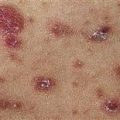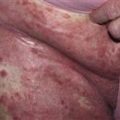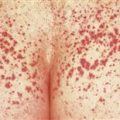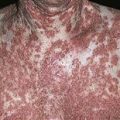42
Pityriasis rosea
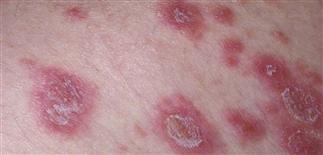
The primary lesion is an oval, salmon-colored, 1- to 10-cm plaque that forms a round collarette of scale in the center.

Lesions are found on the trunk and usually spare the face and extremities.
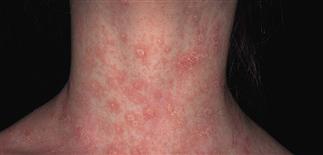
The number of lesions is highly variable. Plaques may extend to the neck and proximal limbs.
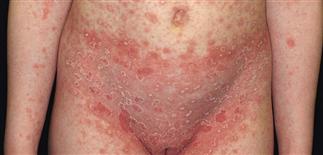
Numerous lesions may appear. A concentration of lesions on the groin and lower abdomen is highly characteristic, especially in children.
DESCRIPTION
Common, usually asymptomatic, seasonal, possibly post-viral, possibly contagious, highly characteristic, self-limited eruption.
HISTORY
• Most patients between the ages of 15 and 35. • May begin with mild upper respiratory symptoms. May or may not begin with a single lesion on the trunk, the ‘herald patch’, which is larger than subsequent lesions. A few to numerous lesions then suddenly appear 1–2 weeks later. • Itching is mild or absent. Itching may be intense in extensive cases. • Lesions clear without treatment in 4–12 weeks.
PHYSICAL FINDINGS
• The lesion is a salmon-colored, oval plaque 1–2 cm in diameter. The long axis of the oval lesions is oriented horizontally. • Lesions are dark brown on African-American skin and sometimes difficult to see. • A round rim of scale rapidly forms inside the border. • Plaques sometimes very large and misdiagnosed as fungal infection (ringworm). • Lesions are located on trunk and proximal extremities, often concentrated on lower abdomen. • Dark-brown postinflammatory pigmentary changes may take months to resolve in darker-skinned people.
TREATMENT
• Mentholated lotions (Sarna) or sprays (Eucerin Anti-Itch) for itching. • Sun exposure or ultraviolet B light in a dermatologist office hastens resolution. • Erythromycin stearate 250 mg q.i.d. (for adults) or 25–40 mg/kg in four divided doses in children for 2 weeks may clear the eruption. • Group V topical steroids and oral antihistamines provide some relief. • Prednisone (20 mg b.i.d. for 1 week) used for extensive cases with intense itching.


